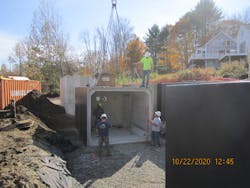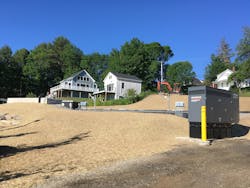Establishing a sewer district and treatment system in a small coastal town
Situated in Maine’s Midcoast region, the Town of Lincolnville is home to approximately 2,250 residents. During the summer months, tourists flock to this region to take in the quaint downtowns and rocky coastline.
Lincolnville Beach offers a reprieve from the rocks with a short sandy strip perfect for sunbathing, swimming or launching a kayak, adjacent to the main thoroughfare. Overlooking Penobscot Bay and the Island of Isleboro, the beach is close to the island ferry service and within walking distance to antique shops, galleries, a local museum and several restaurants.
Like many small communities, most residents and businesses historically relied on privately owned septic systems and overboard discharges for wastewater disposal, and a handful of restaurants discharged their wastewater to a small private treatment facility. These aging and failing systems were leading residents to voice concerns about drinking well water quality, as well as the environmental impact on Lincolnville Beach and Penobscot Bay.
The Lincolnville Sewer District was established to evaluate different wastewater treatment options and funding resources to implement a public wastewater collection system and treatment facility in the beach area.
Creating a right-sized solution
Lincolnville Sewer District officials partnered with Woodard & Curran to conduct an alternatives analysis to determine the most effective, affordable option for the community.
One idea was to tie Lincolnville’s wastewater collection system into a neighboring town’s treatment system, but constructing more than 5 miles of sewer lines to tie into Camden’s system was too costly. However, building a small, localized collection system and package treatment plant balanced affordability and long-term benefits to meet community needs at a manageable investment.
The existing submersible pump stations were also able to be reused, with minor modifications made to accommodate larger pumps that could handle the additional flows. An energy-efficient, customizable, on-site wastewater treatment solution was selected to provide biological treatment, and ultraviolet irradiation was included for disinfection.
The new WRF was built on a steep slope behind a busy ferry terminal on Route 1, overlooking Penobscot Bay. This challenging, quarter-acre parcel of land was a key factor in choosing the treatment system, which is suitable for small spaces with the capacity to treat the design average day flow of 25,000 gallons per day.
Another key component to the project included provisions for fats, oils, and grease (FOG) trapping and collection mechanisms at source locations. Several commercial connections to the system are seasonal food establishments, which makes it critical to remove as much FOG at the source as possible to reduce wear on the collection system and overall operations costs.
The town was encouraged to collaborate with restaurants to install grease traps/receptors or automatic grease recovery units. The Lincolnville Sewer District also incorporated this provision into its sewer use ordinance.
Funding critical infrastructure
While the collection system and associated WRF was critical for protecting the area’s environment and water quality, the system has so few users that user fees would not be enough to pay back this significant investment.
Several funding avenues were identified to back this project, including a $1 million grant from the Maine Department of Environmental Protection; a $1 million grant and $1.6 million loan from the U.S. Department of Agriculture, Rural Development; a $500,000 Community Development Block Grant; and a $250,000 grant from the Northern Border Regional Commission.
A public outreach campaign helped garner the necessary support from area residents and businesses to establish the Lincolnville Sewer District, which used these funds to cover construction and startup costs in lieu of existing ratepayer fees.
The town also implemented incentives to homeowners willing to disconnect their septic tanks and tie into the new sewer system, such as covering the installation cost for 20 grinder pump stations at homes situated at a lower elevation than the new gravity sewer line.
Small & successful
Woodard & Curran also advised the Lincolnville Sewer District on hiring a contract operator for the new WRF. The contract operator visits the site several times a week to check the system and collect samples that are sent to an independent laboratory for testing.
The new wastewater collection system and associated WRF have been online for two years. Effluent produced through the treatment process is consistently testing at a higher quality than required by the facility’s discharge permit. Approximately half of the anticipated users are now connected to the system, with more connections anticipated.
With summer businesses open for the season, locals and tourists can visit Lincolnville Beach, eat locally harvested clams, and recreate in the waters of Penobscot Bay knowing the environment is being kept safe and healthy for all to enjoy.
Julianne Page, PE, is a technical manager at Woodard & Curran with more than ten years of experience in municipal wastewater engineering. She has led design and construction administration efforts for a variety of projects throughout the United States including wastewater treatment plants, pump stations and collection systems.
About the Author
Julianne Page
Julianne Page, PE, is a technical manager at Woodard & Curran with more than ten years of experience in municipal wastewater engineering. She has led the design and construction administration efforts for a variety of projects throughout the United States including wastewater treatment plants, pump stations and collection systems.



